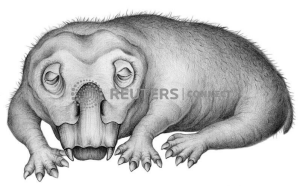Mammal-like Triassic creature beat polar winters by hibernating
 Send a link to a friend
Send a link to a friend
 [September 05, 2020]
By Will Dunham [September 05, 2020]
By Will Dunham
WASHINGTON (Reuters) - The tusks of a
stoutly built plant-eating mammal relative that inhabited Antarctica 250
million years ago are providing the oldest-known evidence that animals
resorted to hibernation-like states to get through lean times such as
polar winters.
The research published on Thursday focused on a four-legged forager
called Lystrosaurus whose fossils have been found in China, Russia,
India, South Africa and Antarctica. It was an early member of the
evolutionary lineage that later gave rise to mammals.
The findings indicated that Lystrosaurus entered a state of torpor - a
temporary reduction in metabolic activity - to cope with the long,
perpetually dark winters in the Antarctic Circle when food was scarce,
although Earth then was much warmer than today and the region was not
ice-bound.

The findings also suggested Lystrosaurus, which may have had hair, was
warm-blooded.
Hibernation is a form of torpor found in warm-blooded animals like
certain bears, rodents, echidnas, hedgehogs and badgers.
Lystrosaurus, ranging from roughly the size of a pig to the size of a
cow, possessed a turtle-like beak and lacked teeth except for a pair of
ever-growing tusks protruding from its face useful for digging up tasty
roots and tubers. These tusks had incremental growth marks visible in
the form of dentine - the hard tissue that forms the bulk of a tooth -
deposited in concentric circles like tree rings.
[to top of second column]
|

An artist's rendition shows the Triassic Period mammal relative
Lystrosaurus in a hibernation-like state, released on August 27,
2020 by the University of Washington. Crystal Shin/Handout via
REUTERS.

The researchers examined tusk cross-sections from six Lystrosaurus
individuals from Antarctica and four from South Africa, away from
the polar conditions. The Antarctic tusks bore closely spaced, thick
rings suggestive of periods of less deposition during a
hibernation-like state.
"Torpor is an incredibly common physiological phenomenon in animals
today," said Harvard University paleontologist Megan Whitney, lead
author of the research published in the journal Communications
Biology.
"We expect that torpor has been a commonly employed adaptation for a
very long time," said Whitney, who worked on the research while at
the University of Washington. "However, this is difficult to test in
the fossil record, especially deep in time hundreds of millions of
years ago."
Such resilience may help explain why Lystrosaurus, which predated
dinosaurs by millions of years, survived the worst mass extinction
in Earth's history 252 million years ago, as the Permian Period
ended and the Triassic Period began.
(Reporting by Will Dunham; Editing by Sandra Maler)
[© 2020 Thomson Reuters. All rights
reserved.] Copyright 2020 Reuters. All rights reserved. This material may not be published,
broadcast, rewritten or redistributed.
Thompson Reuters is solely responsible for this content. |